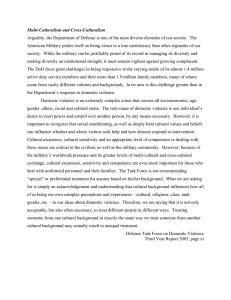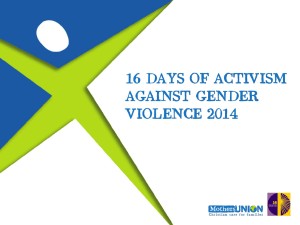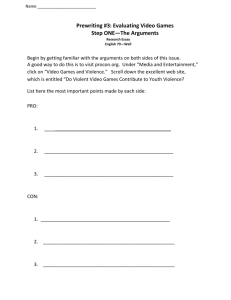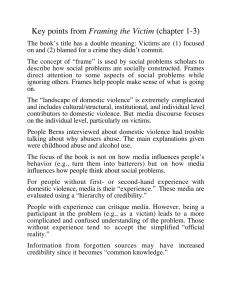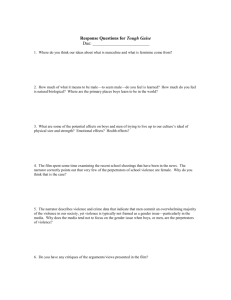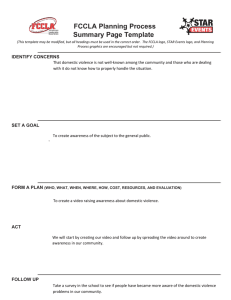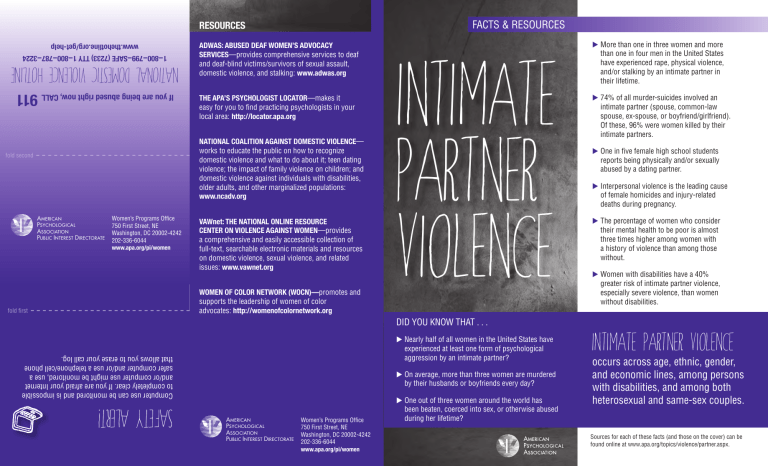
FACTS & RESOURCES
RESOURCES
ADWAS: ABUSED DEAF WOMEN’S ADVOCACY
SERVICES—provides comprehensive services to deaf
and deaf-blind victims/survivors of sexual assault,
domestic violence, and stalking: www.adwas.org
THE APA’S PSYCHOLOGIST LOCATOR—makes it
easy for you to find practicing psychologists in your
local area: http://locator.apa.org
1−800−799−SAFE (7233) TTY 1−800−787−3224
www.thehotline.org/get-help
NATIONAL DOMESTIC VIOLENCE HOTLINE
If you are being abused right now, CALL
911
NATIONAL COALITION AGAINST DOMESTIC VIOLENCE—
works to educate the public on how to recognize
domestic violence and what to do about it; teen dating
violence; the impact of family violence on children; and
domestic violence against individuals with disabilities,
older adults, and other marginalized populations:
www.ncadv.org
fold second
AMERICAN
PSYCHOLOGICAL
ASSOCIATION
PUBLIC INTEREST DIRECTORATE
Women’s Programs Office
750 First Street, NE
Washington, DC 20002-4242
202-336-6044
www.apa.org/pi/women
VAWnet: THE NATIONAL ONLINE RESOURCE
CENTER ON VIOLENCE AGAINST WOMEN—provides
a comprehensive and easily accessible collection of
full-text, searchable electronic materials and resources
on domestic violence, sexual violence, and related
issues: www.vawnet.org
Intimate
Partner
Violence
WOMEN OF COLOR NETWORK (WOCN)—promotes and
supports the leadership of women of color
advocates: http://womenofcolornetwork.org
fold first
DID YOU KNOW THAT . . .
Nearly half of all women in the United States have
experienced at least one form of psychological
aggression by an intimate partner?
Computer use can be monitored and is impossible
to completely clear. If you are afraid your Internet
and/or computer use might be monitored, use a
safer computer and/or use a telephone/cell phone
that allows you to erase your call log.
On average, more than three women are murdered
by their husbands or boyfriends every day?
AMERICAN
PSYCHOLOGICAL
ASSOCIATION
PUBLIC INTEREST DIRECTORATE
Women’s Programs Office
750 First Street, NE
Washington, DC 20002-4242
202-336-6044
www.apa.org/pi/women
One out of three women around the world has
been beaten, coerced into sex, or otherwise abused
during her lifetime?
More than one in three women and more
than one in four men in the United States
have experienced rape, physical violence,
and/or stalking by an intimate partner in
their lifetime.
74% of all murder-suicides involved an
intimate partner (spouse, common-law
spouse, ex-spouse, or boyfriend/girlfriend).
Of these, 96% were women killed by their
intimate partners.
One in five female high school students
reports being physically and/or sexually
abused by a dating partner.
Interpersonal violence is the leading cause
of female homicides and injury-related
deaths during pregnancy.
The percentage of women who consider
their mental health to be poor is almost
three times higher among women with
a history of violence than among those
without.
Women with disabilities have a 40%
greater risk of intimate partner violence,
especially severe violence, than women
without disabilities.
Intimate Partner Violence
occurs across age, ethnic, gender,
and economic lines, among persons
with disabilities, and among both
heterosexual and same-sex couples.
Sources for each of these facts (and those on the cover) can be
found online at www.apa.org/topics/violence/partner.aspx.
SAFETY ALERT!
FACTS FROM PSYCHOLOGICAL RESEARCH
FORMS OF PSYCHOLOGICAL AGGRESSION
Your risk of experiencing intimate partner
violence increases if you are:
EXPRESSIVE AGGRESSION is when your intimate
partner has
Poor
called you names (e.g., fat, ugly, crazy, stupid)
Less educated
insulted, humiliated, or made fun of you
An adolescent or a young adult
called you a loser, a failure, or not good enough
Female
told you no one else would want you
Living in a high-poverty neighborhood
acted very angry in a way that seemed dangerous
Low income
Low academic achievement
Young age
If you have been victimized by an intimate
partner—recently or in the past—you may
experience one or many of the following:
Depression
Suicidal thoughts and/or behavior
Anxiety
Low self-esteem
Inability to trust
Dependent on drugs or alcohol
The following increase someone’s chances
of becoming an abusive partner:
WHAT YOU CAN DO TO HELP YOURSELF
COERCIVE CONTROL is when your intimate
partner has
Fear of intimacy
Isolation
made decisions that should have been yours
to make
Posttraumatic stress disorder
Identify safe areas of the house where there are no weapons
(e.g., not the kitchen) and there are ways to escape. If
arguments begin, try to move to one of those areas.
Emotional detachment
made threats to physically harm you
Flashbacks
Depression
threatened to hurt him/herself or commit suicide
because s/he was upset
Replaying assault in mind
Few friends and isolation from other people
Unemployment
threatened to hurt a pet or take a pet away
threatened to hurt someone you love
threatened to take your children away from you
Emotional dependence and insecurity
kept you from leaving the house when you
wanted to go
Belief in strict gender roles (e.g., male dominance)
kept you from having your own money to use
Desire for power and control in relationships
destroyed something that was important to you
Being a victim of child physical or
psychological abuse
SAFETY PLANNING
Identify your partner’s use and level of force so that you
can tell when you and your children are in danger before
it occurs.
Heavy alcohol and drug use
Prior history of being physically abusive
Seek help from a psychologist or other licensed
mental health provider; contact your doctor or other
primary health care provider; engage the services at
centers or shelters for battered women.
Risky behaviors (unhealthy eating, sexual
behaviors, and dependence on substances)
Sleep disturbances
Anger and hostility
Secure a restraining or protective order if
necessary—it prohibits an individual from
harassing, threatening, approaching, accosting, or
even contacting you. Always keep it with you.
tried to keep you from seeing or talking to family
or friends
kept track of you by demanding to know where
you were and what you were doing
Aggressive behavior as a youth
Connect with supportive and caring people, not those
who might blame you for the abuse.
Poor physical health (frequent headaches,
chronic pain, and activity limitations)
If violence occurs, make yourself a small target—dive into a
corner and curl up into a ball, with your face protected and arms
around each side of your head, fingers entwined.
If possible, have a phone handy at all times and know what
numbers to call for help.
Don’t be afraid to call the police.
Let trusted friends and neighbors know of your situation,
and develop a plan and visual signal for when you need help.
Pack a bag (include money, an extra set of keys, copies of
important documents, extra clothes and medicines) and
leave it in a safe place or with someone you trust.
Teach your children how to get help. Instruct them not to get
involved in the violence between you and your partner. Plan a code
word to signal to them that they should get help or leave the house.
Practice how to get out safely. Practice with your
children.
Call a domestic violence hotline periodically to assess
your options and get support and understanding.


